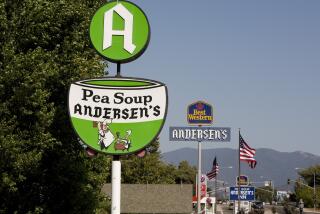Ways to Lower Fat, Not Flavor
- Share via
There’s a school of thought that says some things should just be left alone. For example, why try to make a low-fat cheesecake? The end result doesn’t taste like cheesecake, isn’t really cheesecake and shouldn’t even be called cheesecake.
The same holds true of peanut-butter cookies. You really can’t make them without peanut butter. They’ll always be high in fat, even if it’s a nice, monounsaturated fat.
But reworking a recipe doesn’t have to mean that you end up with a strange-tasting substance on your plate. Here are some substitutions that will help you cut down on the fat content of your meals.
Evaporated skim milk: Use this, instead of heavy cream, in all kinds of recipes. Evaporated milk is good in desserts, creamy sauces or soups. It tastes like cream and has a richer texture than regular skim milk. For every cup used in place of a cup of cream, you’ll save 80 grams of fat and 600 calories.
Fat-free plain yogurt: Substitute for whole sour cream. (Unfortunately, fat-free sour cream doesn’t have the rich body or flavor of plain yogurt.) You’ll also get more calcium than you would with sour cream.
Marshmallow creme: Instead of margarine or butter in recipes that call for fluffy frosting, try this. It adds creaminess and no fat, but (of course) a lot of sugar.
Applesauce: Use applesauce instead of oil, margarine or butter in many baked products. For each half-cup substitution, you’ll save more than 900 calories and 100 grams of fat. In recipes where oil is the only liquid, try half applesauce and half buttermilk. This takes a little experimentation. Figure it out before you invite company over.
Prunes: Pureed prunes or baby-food prunes work as oil and fat replacers in chocolate baked goods. The dark color and rich flavor of the chocolate disguise the prunes, so you probably won’t even know they’re there. For each half-cup of prune puree, you’ll save nearly 800 calories and more than 100 grams of fat.
Egg whites: Use two egg whites to substitute for each whole egg. You’ll save only 5 grams of fat (because eggs are fairly low in fat), but you will save 213 milligrams of cholesterol for each egg yolk that you don’t use.
*
Dr. Sheldon Margen is a professor of public health at UC Berkeley; Dale A. Ogar is managing editor of the UC Berkeley Wellness Letter. Send questions to Dale Ogar, School of Public Health, UC Berkeley, Berkeley, CA 94720-7360, or e-mail to daogar@wellnessletter.com. Eating Smart appears occasionally in Health.
More to Read
Eat your way across L.A.
Get our weekly Tasting Notes newsletter for reviews, news and more.
You may occasionally receive promotional content from the Los Angeles Times.










